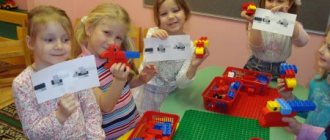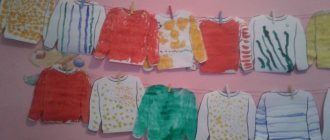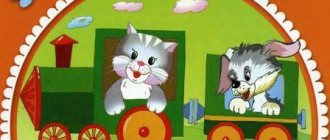Summary of GCD in the middle group. Digit and number 3
Lesson summary for children 4-5 years old “Number and number 3”
Author: Khashaeva Albina Aleksandrovna, teacher, Secondary School No. 74 (d/o), Moscow. Description of the material I offer you a summary of direct educational activities for children of the middle group on the topic “Number and number 3.” This is a summary of a lesson in which children become familiar with the concept of a number series, numerals from 1 to 3, and also learn to name them correctly and navigate them correctly. Purpose To familiarize yourself with the formation of the number 3 and the number of the same name;
teach to name the numerals 1, 2 and 3; arrange and count things from left to right with the right hand; learn to navigate in space. Materials
Materials for
the teacher : * ball * cards with numbers Materials for children : * cards with numbers 1, 2 and 3 * identical cubes - 6 pieces * cards with raspberries - 4 pieces * cards with strawberries - 4 pieces * number card Instead of the corresponding cards, you can take toys in the form of raspberries and strawberries.
Progress of the lesson
At the table (sitting) To begin, invite the children to place one cube. — How many dice did you bet? - Now show me this figure. — What figure did they show and why exactly? - Now to the right of the cube, make a column of 2 cubes. - How many cubes are there in this column? That's right, one, two, just two cubes. - What number should be used to denote 2 cubes? Show the number 2. - Now make another column of two cubes next to it and place another one on it. Are there more cubes? - Let's count together how many cubes are in the last column: one, two, three - 3 cubes in total. — The number 3 is indicated by the number 3 ( show
).
— Make sure that the 2nd and 3rd columns have an equal number of cubes - 2 each. Check the correctness of the task.
— What is the number of cubes in the 2nd column?
And in the 3rd? Place another cube in the 3rd column. How many cubes are there in the 3rd column now? Where are there more cubes: in the 2nd or 3rd column? Show the number that represents the number 3. Place the numbers 1 and 2 on the board.
- Where should the number 3 be? After what digit in the number series should it be placed?
Let's play the game
Game “What has changed?” On the board there is a row of numbers from 1 to 3. The guys close their eyes, the teacher removes the number 2. Opening their eyes, they name the “disappeared” number and put it in the right place in the row.
The next time, when the game is repeated, one of the children removes the number. For the first time, it is the number 2 that should be removed, because the children must see the boundaries of the number series. Physical education lesson
“Who is faster?”
— outdoor game Working with a card
The teacher allows the children to raise their right hand and tell individual children which hand they demonstrated.
After this he asks to demonstrate his left hand. Next, the children are asked to place their left hand on the card on the left side, and with their right hand to arrange the berries from left to right. — Place this many strawberries on the top “shelf” of the card. Indicates the number 2.
- How many strawberries are on the card?
Show me 2 strawberries. The guys make a circular gesture, circling two strawberries.
- Place the same number of raspberries at the bottom. How many raspberries did you put in? — What can you say about raspberries and strawberries? — Place another raspberry in the row. Which berries have become smaller? Which ones are there more? — What needs to be done to make them equal, 3 each? — What number should be placed next to raspberries and strawberries? Why this number?
Tips for parents
After the lesson, you can recommend to parents how to help children fix the number 3 in everyday life. For example, put 3 cups on the table and ask the question: “How many plates and spoons should be placed if there are 3 people eating?”
We recommend watching:
Summary of a comprehensive lesson on FEMP with elements of application in the middle group. Summary of a lesson in mathematics in the middle group of kindergarten. Synopsis of a game-based cognitive lesson on FEMP in the middle group. Synopsis of joint activities on mathematical development for children of the middle group.
Similar articles:
Math lesson “Rectangle” in the middle group of kindergarten
Mathematics lesson “Ordinal counting” in the middle group
Summary of a lesson in mathematics in the preparatory group: Number and figure 4
Lesson summary “Number and figure 4”
Topic: “Number and figure 4” Lesson type: discovery of new knowledge Purpose: 1) Update the idea of the way to indicate quantity using dots, introduce the method of printing the number 4; 2) To consolidate the idea of the composition of the number 4, from two smaller ones, the meaning of addition and subtraction, the relationship between part and whole, update ordinal counting, train the ability to find the place of a number in a number series; 3) To consolidate the method of comparing groups of objects by making pairs, the use of the signs “<”, “>” and “=”, the ability to determine on a subject basis how much more or less there are in one group of objects than in another; 4) Create a self-test experience based on a sample, an action according to the algorithm, pronouncing its main steps. Materials for the lesson Demonstration: cards for comparison; house with the composition of the number 4, cards with numbers from 1 to 10, Aibolit toy, cards with animals (cow, horse, dog, fox) Equipment: tape recorder, easel, multimedia.
means Progress of the lesson:
1. Introduction to the situation The lesson begins, It will go well, guys, for the future, Try to understand everything, Find out about numbers with numbers. - Which of you is ready to go for new knowledge? (all) - How many of you have pets? —Does it happen that they get sick? - Who do you contact in this case? (If children name the profession of doctor, doctor, then the teacher asks the question: - Do you know what the name of a person who treats animals is? veterinarian) - What is the name of the veterinarian known to all children? (Aibolit) 2. Play activities A cow, a horse, a dog and a fox came to see Dr. Aibolit. -What can you call in one word those who are depicted in these pictures? (animals) -How many animals came to the reception? (4) But Doctor Aibolit will not be able to accept all the animals at once. - How to be in this case? (I listen to the children’s answers) -So, Aibolit will conduct the reception like this: before lunch he will take one part of the animals, and after lunch – the other part. In order for Aibolit to conveniently record the animals in the journal, they need to be divided so that each part can be called in one word. Task on the interactive board - What parts can the animals that come to the reception be divided into? (domestic and wild) - Will Aibolit, looking at the magazine in a few days, be able to find out how many animals he took in that day? - How can I do that? (you need to add the parts) Children write down the equality 1 + 3 = 4 on the easel - Will the total number of animals change if Aibolit accepts domestic ones first and then wild ones? (no) - What equality can be written down? 3+1=4 -Is it possible to divide the animals differently? (by feeding method: herbivores: cow, horse and predators: dog, fox) Task on the interactive board - How many herbivores? (2) -How many predators? (2) -Let's write down the equality on the easel. Children write down the equality 2+2=4 on the easel - What can be said about the whole in all the written equalities? (the whole is the same everywhere) 3. Discovery of new knowledge (activity at the table) Physical education on your fingers.
Once - get up, stretch.
Two – bend over, straighten up. Three - 3 claps of hands, 3 nods of the head. By four – your arms are wider. Five - wave your arms. Six - sit quietly at your desk. Composition of the number 4 (3+1=4 2+2=4 1+1+1+1=4) Now let's arrange the cubes so that when added together we get the number 4. Each part should be a different color. The children have geometric shapes on their tables, and everyone works with handouts. One child works at the blackboard. - Place 3 cups. Add 1 cube of a different color. How many figures are there in total? — How did you get 4? (3+1) - What happens if you add 3 circles to one square? (Also 4: 1+3) - When the parts are rearranged, the result does not change. - How else can you get the number 4? (2+2, 1+1+1+1) Children connect the cubes. 4. Computers 5. Understanding (result) of the lesson -Where have you been today? -Who did you help? -What number did you meet? -How can you get the number 4? 6. Presentation of young girls
We recommend watching:
Final lesson in mathematics in the preparatory group Notes of a lesson in mathematics in the preparatory group Notes of a lesson on FEMP for the preparatory group with a presentation Notes of a lesson in mathematics for children in the preparatory group
Similar articles:
FEMP entertainment in the preparatory group
Abstract of GCD in mathematics in the preparatory group. Composition of number 5
Summary of a lesson in mathematics in the preparatory group according to the Federal State Educational Standard. Topic: Above, below








